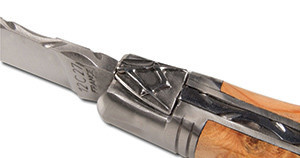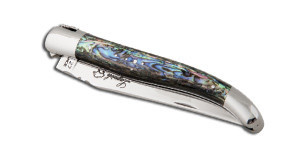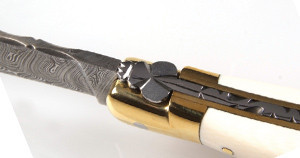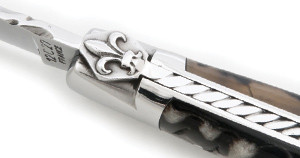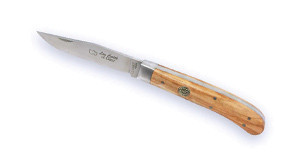The history of leather
The Club collects information from all amateurs of knife-makingIf you want to speak about something important for you, don't hesitate contact us.
The man of Neandertal had a body covered with hair and didn't need any clothes.
However he got into the habit of taking off the skin of the game, he had killed and using it as "umbrella" or "sunshade".
These skins were put on branches and they were taken during of the hunting periods.
The life time of these skins was short because of rain and sun alternations.
But about in the year 8000 BC, a flood occurred creating a upheaval characterized by the appearance of seasons more marked than in the upper Paleolithic.
Rains and sun alternations got more and more frequent.
Then cold became more important which induced man to cover himself to sleep.
To that a genetic modification of Man who began to lose his abundant hair-growth was added.
And very soon, he needed more and more skins .
To reply to this need, he hunted more and more and tried to increase the life time of his skins.
The first means of preserving was salt (also used for the preserving of meat) that the man of this period got it imbued into the raw skin (this conservation lasted until it rained).
So as to make the preserving longer, man got into the habit of skimming skins with clay before putting salt.
From the year 2000 BC a new technique of preserving thanks to smoke.
Smoking was used by men to preserve meat ("smoked meat ").
These men noticed that worn skin during of the smoking became more resistant.
By combining salt and smoke the life time became even longer (we know, today, that green wood combustion with leaves and barks releases gas full of tar and getting fixed in the skins insure a sufficient preserving).
From the year 1000 BC, in central Europe wools got better, from smoking, and the technique of rubbing skins with barks of birch to which they have after added oil of birch which gave the " Leather of Russia " with a very characteristic smell.
During this same period in Africa some tribes had specialized in the processing of skins : they hanged skins to trees and filled them with water and salpetre and left them for 5 days, then they replaced the salpetered water by a water containing barks for two weeks.
The Sumérians were among the first to equip their armies with leather protections, this tradition was then resumed by the Babylonians and the Assyrians.
About in the year 2 000 several nomad peoples domesticated oxen, therefore they no longer needed to hunt to obtain skin. Having more raw materials these peoples started to make leather sandals to protect their feet and started to bury their dead in sewn skins , as mummies.
And it is quite by chance that the first tanner appeared.
According to the books of the Hittites it is about in the year 2200 before our era that a shepherd of the Sinaï having killed a goat, and taking off the skin skimmed it with clay and salt , this was blown away by a whirlwind.
Then it fell into a hollow filled with water rock that had partly dissolved salts of alum.
The presence of salt on the skin favoured the action of alum.
A month later our shepherd with his herd walked past the hollow where his skin had fallen.
He saw it, picked it up made it dry again and put it on.
Contrarily to usual, the skin got white but did not rot.
Puzzled, the shepherd renewed the operation in the same way and once again the skin ceased to decay.
He understood that the water there had some particularities and that it was loaded with salt that he called " Rock Salt ".
Our shepherd had become the first tanner in history.
Near the Sinaï where the Hittites had settled (they were a people of merchants that had made a speciality to sell products of a region to another with caravans). One of them produced leather in this way: Skins were first knocked with sticks, then dived into a bath of alum, dried, and coated with of poppy oil. For nearly 1 000 years them the Hittites were the only ones to tan leather and the prosperity of the Hittite empire was largely based on this secret.
The first centre outside the Hittite empire was opened only in 1249 BC.
The Carthaginians succeeded in discovering the secret of tanning and managed to adapt it to the skins of sheep and therefore were the firsts tawers.
About in the year 1000 BC, they settled a great centre of leather productions of ovine leather with or without hair in the delta of the Rhone near Marseilles. We can imagine that the first leather sheats came up at this time.
Then the descendants of the Hittites were going to settle in Italy.
But with the Gallo-Roman wars the exchanges were more and more limited between the different regions and little by little the work of leather started to decrease.
Some specialists in the delta of the Rhone and in Paris but the bad smells from this by these tanneries displeased the residents of these cities and in the time of the great plague in 542 after C, the people started to blame tanners and tawers for the cause of the spreading of the plague.
In Valence a tanner and his family are beaten to death and thrown into Rhone with all the skins of the manufacture, in Montélimar a tawer was burnt at the stake in his workshop, in Paris according to the records of the watch 91 tanners where
burnt at the stake.





